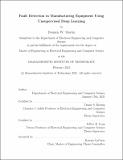Fault detection in manufacturing equipment using unsupervised deep learning
Author(s)
Martin, Damien W.
Download1251800255-MIT.pdf (3.481Mb)
Other Contributors
Massachusetts Institute of Technology. Department of Electrical Engineering and Computer Science.
Advisor
Duane S. Boning and Jeffrey H. Lang.
Terms of use
Metadata
Show full item recordAbstract
We investigate the use of unsupervised deep learning to create a general purpose automated fault detection system for manufacturing equipment. Unexpected equipment faults can be costly to manufacturing lines, but data driven fault detection systems often require a high level of application specific expertise to implement and continued human oversight. Collecting large labeled datasets to train such a system can also be challenging due to the sparse nature of faults. To address this, we focus on unsupervised deep learning approaches, and their ability to generalize across applications without changes to the hyper-parameters or architecture. Previous work has demonstrated the efficacy of autoencoders in unsupervised anomaly detection systems. In this work we propose a novel variant of the deep auto-encoding Gaussian mixture model, optimized for time series applications, and test its efficacy in detecting faults across a range of manufacturing equipment. It was tested against fault datasets from three milling machines, two plasma etchers, and one spinning ball bearing. In our tests, the model is able to detect over 80% of faults in all cases without the use of labeled data and without hyperparameter changes between applications. We also find that the model is capable of classifying different failure modes in some of our tests, and explore other ways the system can be used to provide useful diagnostic information. We present preliminary results from a continual learning variant of our fault detection architecture aimed at tackling the problem of system drift.
Description
Thesis: M. Eng., Massachusetts Institute of Technology, Department of Electrical Engineering and Computer Science, February, 2021 Cataloged from the official PDF of thesis. Includes bibliographical references (pages 87-90).
Date issued
2021Department
Massachusetts Institute of Technology. Department of Electrical Engineering and Computer SciencePublisher
Massachusetts Institute of Technology
Keywords
Electrical Engineering and Computer Science.